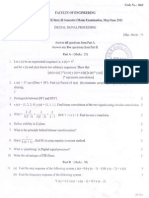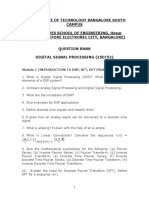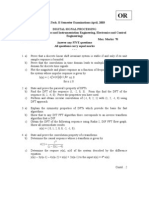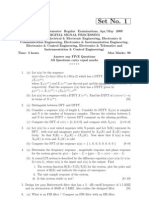DSP (5th) May2019 PDF
Uploaded by
s tharunDSP (5th) May2019 PDF
Uploaded by
s tharunRoll No. Total No.
of Pages : 02
Total No. of Questions : 09
B.Tech. (Electronics Engg.) (2012 Onwards)
B.Tech. (ECE/ETE) (2011 Onwards) (Sem.–5)
DIGITAL SIGNAL PROCESSING
Subject Code : BTEC-502
M.Code : 70546
Time : 3 Hrs. Max. Marks : 60
INSTRUCTION TO CANDIDATES :
1. SECTION-A is COMPULSORY consisting of TEN questions carrying T WO marks
each.
2. SECTION-B contains FIVE questions carrying FIVE marks each and students
have to attempt ANY FOUR questions.
3. SECTION-C contains T HREE questions carrying T EN marks each and students
have to attempt ANY T WO questions.
m
SECTION-A
o
1. Write briefly :
.r c
p e
a) Whether the signal y(n) = sin 3n is periodic or non-periodic?
m
a o
.r c
b) Is the system y(n) = x(n) cos(n) linear or non-linear?
r p
b
c) Give two advantages of digital signal processing over analog signal processing.
p
d) Why the ROC of Z-transform cannot contain any pole ?
e
p a
b r
e) Why it is not possible to take the DFT of sequency having infinite length?
f) In the implementation of a digital system what are the effects of finite-word-length?
g) Give the various steps involved in the design of IIR filter.
h) Differentiate between FIR and IIR filter.
i) What is Gibbs Phenomenon?
j) List the various features of DSP processors.
1 | M-70546 (S2)-998, 999&1000
SECTION-B
2. Compute the convolution of x(n) = u (n) – u (n – 5), h (n) = [1, 2, 2, 1]
3. Determine the Z-transform and sketch the ROC of :
x (n) = –n u (–n –1)
4. Obtain inverse Z-transform using partial fraction expansion method where :
3
X (z) ; x ( n) is causal
1 1 1
z z
4 8
5. The transfer function of analog filter is :
3
H a ( s)
( s 2)( s 3)
m
With T = 0.1sec. Design the digital filter using Bilnear Transformation Technique.
o
.r c
6. Obtain the direct form 1direct form 1I, cascade & parallel structure for the following
system :
p e
y (n) = – 0.1y(n – 1) + 0.2y(n – 1) + 3x(n) + 3.6x(n – 1) + 0.6x(n – 2)
m
a o
r p SECTION-C
.r c
7. b e
Explain the different types of structures for the realization of FIR filter.
p
8. Compute the 8-point DFT of a sequence
p a
1 1 1 1
2 2 2 2 b r
x(n) , , , ,0,0,0,0,
Using in-place radix-2 decimation-in-time (DIT) FFT algorithm.
9. With the help of neat diagram describe the memory architecture of TMS320C54X and
give the comparison between DSP processor and general purpose microprocessor.
NOTE : Disclosure of identity by writing mobile number or making passing request on any
page of Answer sheet will lead to UMC case against the Student.
2 | M-70546 (S2)-998, 999&1000
You might also like
- Study - Id22628 - Internet Usage in India Statista DossierNo ratings yetStudy - Id22628 - Internet Usage in India Statista Dossier40 pages
- Digital Signal Processing R13 Previous Papers100% (1)Digital Signal Processing R13 Previous Papers5 pages
- CHRIST (Deemed To Be University), Bangalore - 560 029 End Semester Examination - April /may - 2023No ratings yetCHRIST (Deemed To Be University), Bangalore - 560 029 End Semester Examination - April /may - 20233 pages
- C F1048 Pages:2: Answer Any Two Full Questions, Each Carries 15 MarksNo ratings yetC F1048 Pages:2: Answer Any Two Full Questions, Each Carries 15 Marks2 pages
- WWW - Manaresults.co - In: Digital Signal ProcessingNo ratings yetWWW - Manaresults.co - In: Digital Signal Processing7 pages
- Ec301 Digital Signal Processing, December 2023No ratings yetEc301 Digital Signal Processing, December 20232 pages
- 2022 Set A PYQ Paper - Digital Signal Processing PYQ Paper For Sem V Uploaded by Navdeep Raghav (DU Academic Corner)No ratings yet2022 Set A PYQ Paper - Digital Signal Processing PYQ Paper For Sem V Uploaded by Navdeep Raghav (DU Academic Corner)4 pages
- WWW - Manaresults.co - In: Digital Signal ProcessingNo ratings yetWWW - Manaresults.co - In: Digital Signal Processing1 page
- B.Tech (EC, VI SEM) : Ii) All Questions Carry Equal MarksNo ratings yetB.Tech (EC, VI SEM) : Ii) All Questions Carry Equal Marks2 pages
- Answer Any Two Full Questions, Each Carries 15 Marks: Reg No.: - NameNo ratings yetAnswer Any Two Full Questions, Each Carries 15 Marks: Reg No.: - Name2 pages
- Set No: 1: Code: V3218/R07 Digital Signal Processing Time: 3 Hours Max. Marks: 80No ratings yetSet No: 1: Code: V3218/R07 Digital Signal Processing Time: 3 Hours Max. Marks: 804 pages
- ECE-AM-2012-EC1302-DIGITAL SIGNAL PROCESSING-958152141-EC1302(full permission)No ratings yetECE-AM-2012-EC1302-DIGITAL SIGNAL PROCESSING-958152141-EC1302(full permission)3 pages
- Digital Signal Processing: Instructions To CandidatesNo ratings yetDigital Signal Processing: Instructions To Candidates3 pages
- How To Design An FIR Filter Using Frequency Sampling Method? For What Type of Filters The Frequency Sampling Method Is Suitable?No ratings yetHow To Design An FIR Filter Using Frequency Sampling Method? For What Type of Filters The Frequency Sampling Method Is Suitable?3 pages
- Note: Answer All Questions From Part A. Answer Any Five Questions From Part BNo ratings yetNote: Answer All Questions From Part A. Answer Any Five Questions From Part B1 page
- Some Case Studies on Signal, Audio and Image Processing Using MatlabFrom EverandSome Case Studies on Signal, Audio and Image Processing Using MatlabNo ratings yet
- Standard and Super-Resolution Bioimaging Data Analysis: A PrimerFrom EverandStandard and Super-Resolution Bioimaging Data Analysis: A PrimerNo ratings yet
- Fundamentals of Electronics 3: Discrete-time Signals and Systems, and Quantized Level SystemsFrom EverandFundamentals of Electronics 3: Discrete-time Signals and Systems, and Quantized Level SystemsNo ratings yet
- Ôn Tập Chương Trình Mới Unit 10: Communication Có Đáp ÁnNo ratings yetÔn Tập Chương Trình Mới Unit 10: Communication Có Đáp Án12 pages
- Understanding Phase Locked Dro Design Aspects100% (1)Understanding Phase Locked Dro Design Aspects8 pages
- Communication Systems of High-Speed Railway: A SurveyNo ratings yetCommunication Systems of High-Speed Railway: A Survey24 pages
- Subnet Name Needed Size Allocated Size Address Mask Dec Mask Assignable Range BroadcastNo ratings yetSubnet Name Needed Size Allocated Size Address Mask Dec Mask Assignable Range Broadcast1 page
- AW8057 Rev A - PrisMax Communication Programmers GuideNo ratings yetAW8057 Rev A - PrisMax Communication Programmers Guide21 pages
- McKinsey Telecoms. RECALL No. 07, 2009 - B2B100% (1)McKinsey Telecoms. RECALL No. 07, 2009 - B2B68 pages
- 》RP-G0800W: 8-P Gigabit Web-Smart SwitchNo ratings yet》RP-G0800W: 8-P Gigabit Web-Smart Switch1 page
- ATM Adaptation Layer - Wikipedia, The Free EncyclopediaNo ratings yetATM Adaptation Layer - Wikipedia, The Free Encyclopedia2 pages
- 4EL33_IDP_Project_ppt_Akshay_Singh(21EL083)No ratings yet4EL33_IDP_Project_ppt_Akshay_Singh(21EL083)19 pages
- Honeywell Gsmvlp5 Honeywell Ilp5 Install GuideNo ratings yetHoneywell Gsmvlp5 Honeywell Ilp5 Install Guide4 pages

























































































